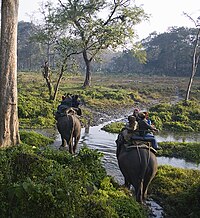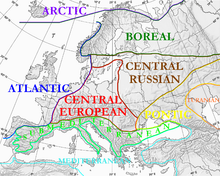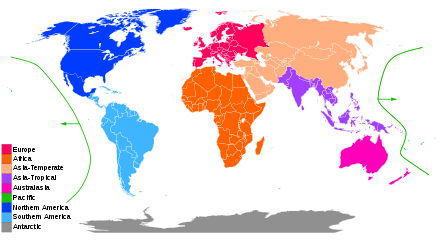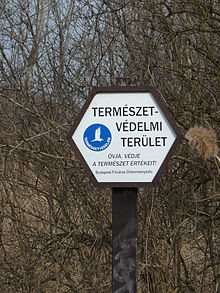Protected areas or conservation areas are locations which receive protection because of their recognized natural, ecological and/or cultural values. There are several kinds of protected areas, which vary by level of protection depending on the enabling laws of each country or the regulations of the international organisations involved. The term "protected area" also includes Marine Protected Areas, the boundaries of which will include some area of ocean, and Transboundary Protected Areas that overlap multiple countries which remove the borders inside the area for conservation and economic purposes. There are over 161,000 protected areas in the world (as of October 2010) with more added daily, representing between 10 and 15 percent of the world's land surface area. By contrast, only 1.17% of the world's oceans is included in the world's ~6,800 Marine Protected Areas.
World map with total percentage of each country under protection.
Protected areas are essential for biodiversity conservation, often providing habitat and protection from hunting for threatened and endangered species. Protection helps maintain ecological processes that cannot survive in most intensely managed landscapes and seascapes.
Definition
Generally, protected areas are understood to be those in which human occupation or at least the exploitation of resources is limited. The definition that has been widely accepted across regional and global frameworks has been provided by the International Union for Conservation of Nature (IUCN) in its categorisation guidelines for protected areas. The definition is as follows:

A poster of Yellowstone from 1938.
Protection of Natural Resources
Protected areas are designated with the objective of conserving biodiversity and providing an indicator for that conservation's progress, but the extent to which they defend resources and ecosystem dynamics from degradation are slightly more complex. Protected areas will usually encompass several other zones that have been deemed important for particular conservation uses, such as Important Bird Areas (IBA) and Endemic Bird Areas (EBA), Centres of Plant Diversity (CBD), Indigenous and Community Conserved Areas (ICCA), Alliance for Zero Extinction Sites (AZE) and Key Biodiversity Areas (KBA) among others. Likewise, a protected area or an entire network of protected areas may lie within a larger geographic zone that is recognised as a terrestrial or marine ecoregions (see, Global 200), or a crisis ecoregions for example. As a result, Protected Areas can encompass a broad range of governance types. Indeed, governance of protected areas has emerged a critical factor in their success.
Subsequently, the range of natural resources that any one protected area may guard is vast. Many will be allocated primarily for species conservation whether it be flora or fauna or the relationship between them, but protected areas are similarly important for conserving sites of (indigenous) cultural importance and considerable reserves of natural resources such as;
- Carbon Stocks: Carbon emissions from deforestation account for an estimated 20% of global carbon emissions, so in protecting the worlds carbon stocks greenhouse gas emissions are reduced and longterm land cover change is prevented, which is an effective strategy in the struggle against global warming. Of all global terrestrial carbon stock, 15.2% is contained within protected areas. Protected areas in South America hold 27% of the world's carbon stock, which is the highest percentage of any country in both absolute terms and as a proportion of the total stock.
- Rainforests: 18.8% of the world's forest is covered by protected areas and sixteen of the twenty forest types have 10% or more protected area coverage. Of the 670 ecoregions with forest cover, 54% have 10% or more of their forest cover protected under IUCN Categories I – VI.
- Mountains: Nationally designated protected areas cover 14.3% of the world’s mountain areas, and these mountainous protected areas made up 32.5% of the world’s total terrestrial protected area coverage in 2009. Mountain protected area coverage has increased globally by 21% since 1990 and out of the 198 countries with mountain areas, 43.9% still have less than 10% of their mountain areas protected.
Annual updates on each of these analyses are made in order to make comparisons to the Millennium Development Goals and several other fields of analysis are expected to be introduced in the monitoring of protected areas management effectiveness, such as freshwater and marine or coastal studies which are currently underway, and islands and drylands which are currently in planning.
IUCN Protected Area Management Categories
Through its World Commission on Protected Areas (WCPA), the IUCN has developed six Protected Area Management Categories that define protected areas according to their management objectives, which are internationally recognised by various national governments and the United Nations. The categories provide international standards for defining protected areas and encourage conservation planning according to their management aims.
Strict Nature reserve Belianske Tatras in Slovakia.
IUCN Protected Area Management Categories:
- Category Ia — Strict Nature Reserve
- Category Ib — Wilderness Area
- Category II — National Park
- Category III — Natural Monument or Feature
- Category IV — Habitat/Species Management Area
- Category V — Protected Landscape/Seascape
- Category VI – Protected Area with sustainable use of natural resources
Protected areas are cultural artifacts, and their story is entwined with that of human civilization. Protecting places and resources is by no means a modern concept, whether it be indigenous communities guarding sacred sites or the convention of European hunting reserves. Over 2000 years ago, royal decrees in India protected certain areas. In Europe, rich and powerful people protected hunting grounds for a thousand years. Moreover, the idea of protection of special places is universal: for example, it occurs among the communities in the Pacific ("tapu" areas) and in parts of Africa (sacred groves). However, the modern protected areas movement had nineteenth-century origins in North America, Australia, New Zealand and South Africa. Other countries were quick to follow suit. While the idea of protected areas spread around the world in the twentieth century, the driving force was different in different regions. Thus, in North America, protected areas were about safeguarding dramatic and sublime scenery; in Africa, the concern was with game parks; in Europe, landscape protection was more common.
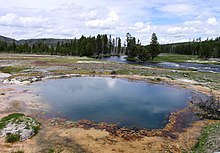
Black Opal Spring in Yellowstone National Park in the United States. Yellowstone, the world's second official protected area (after Mongolia's Bogd Khan Mountain), was declared a protected area in 1872, and it encompasses areas which are classified as both a National Park (Category II) and a Habitat Management Area (Category IV).
Initially, protected areas were recognised on a national scale, differing from country to country until 1933, when an effort to reach an international consensus on the standards and terminology of protected areas took place at the International Conference for the Protection of Fauna and Flora in London. At the 1962 First World Conference on National Parks in Seattle the effect the Industrial Revolution had had on the world's natural environment was acknowledged, and the need to preserve it for future generations was established.
Since then, it has been an international commitment on behalf of both governments and non-government organisations to maintain the networks that hold regular revisions for the succinct categorisations that have been developed to regulate and record protected areas. In 1972, the Stockholm Declaration of the United Nations Conference on the Human Environment endorsed the protection of representative examples of all major ecosystem types as a fundamental requirement of national conservation programmes. This has become a core principle of conservation biology and has remained so in recent resolutions - including the World Charter for Nature in 1982, the Rio Declaration at the Earth Summit in 1992, and the Johannesburg Declaration 2002.
Recently, the importance of protected areas has been brought to the fore at the threat of human-induced global warming and the understanding of the necessity to consume natural resources in a sustainable manner. The spectrum of benefits and values of protected areas is recognised not only ecologically, but culturally through further development in the arena of Indigenous and Community Conserved Areas (ICCAs). International programmes for the protection of representative ecosystems remain relatively progressive (considering the environmental challenges of globalisation with respect to terrestrial environments), with less advances in marine and freshwater biomes.
ChallengesHow to manage areas protected for conservation brings up a range of challenges - whether it be regarding the local population, specific ecosystems or the design of the reserve itself - and because of the many unpredicatable elements in ecology issues, each protected area requires a case-specific set of guidelines.
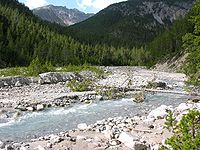
Schweizerischer National Park in the Swiss Alps is a Strict Nature Reserve (Category Ia).
Enforcing protected area boundaries is a costly and labour-heavy endeavour, particularly if the allocation of a new protected region places new restrictions on the use of resources by the native people which may lead to their subsequent displacement. This has troubled relationships between conservationists and rural communities in many protected regions and is often why many Wildlife Reserves and National Parks face the human threat of poaching for the illegal bushmeat or trophy trades, which are resorted to as an alternative form of substinence.
There is increasing pressure to take proper account of human needs when setting up protected areas and these sometimes have to be "traded off" against conservation needs. Whereas in the past governments often made decisions about protected areas and informed local people afterwards, today the emphasis is shifting towards greater discussions with stakeholders and joint decisions about how such lands should be set aside and managed. Such negotiations are never easy but usually produce stronger and longer-lasting results for both conservation and people.
The Jaldapara National Park, in West Bengal, India is a Habitat Management Area (Category IV).
In some countries, protected areas can be assigned without the infrastructure and networking needed to substitute consumable resources and subtantiatively protect the area from development or misuse. The soliciting of protected areas may require regulation to the level of meeting demands for food, feed, livestock and fuel, and the legal enforcement of not only the protected area itself but also 'buffer zones' surrounding it, which may help to resist destabilisation.
EffectivenessOne of the main concerns regarding protected areas on land and sea is their effectiveness at preventing the ongoing loss of biodiversity. There are multiple case studies indicating the positive effects of protected areas on terrestrial and marine species. However, those cases do not represent the majority of protected areas. Several limitations that may preclude their success include: their small size and large isolation to each other (both of these factors influence the maintenance of species), their limited role at preventing the many factors affecting biodiversity (e.g. climate change, invasive species, pollution), their large cost and their increasing conflict with human demands for nature's goods and services.
By Area
European Union
Natura 2000 is a network of protected areas established by the European Union across all Member States. It is made up of Special Areas of Conservation (SACs) and Special Protection Areas (SPAs) designated respectively under the Habitats Directive and Birds Directive. 787,767 km2 (304,159 sq mi) are designated as terrestrial sites and 251,564 km2(97,129 sq mi) as marine sites. Overall, 18 percent of the EU land mass is designated.
Nicaragua
O Parks, Wildlife, and Recreation is a Private Protected Area also known as a 'Private Reserve' predominantly managed for biodiversity conservation, protected without formal government recognition and is owned and stewarded by the O corporation International. O parks plays a particularly important role in conserving critical biodiversity in a section of the Mesoamerican Biological Corridor, known as the Paso del Istmo, located along the 12-mile-wide isthmus between Lake Nicaragua and the Pacific Ocean.
United States
As of 31 January 2008, according to the United Nations Environment Programme, the United States had a total of 6,770 terrestrial nationally designated (federal) protected areas. These protected areas cover 2,607,131 km2(1,006,619 sq mi), or 27.08 percent of the land area of the United States. This is also one-tenth of the protected land area of the world.

Prohibited activities and safety instructions at a state park in Oregon.
References
- ^ Protected Planet.
- ^ Soutullo, A. 2010. Extent of the Global Network of Terrestrial Protected Areas. Conservation Biology 24(2):362-363. http://onlinelibrary.wiley.com/doi/10.1111/j.1523-1739.2010.01465.x/abstract.
- ^ United Nations MDG Report 2010.
- ^ a b c d Mora C, Sale P (2011). "Ongoing global biodiversity loss and the need to move beyond protected areas: A review of the technical and practical shortcoming of protected areas on land and sea" (PDF). Marine Ecology Progress Series 434: 251–266. doi:10.3354/meps09214.
- ^ IUCN (2010) Global Ocean Protection: Present Status and Future Possibilities.
- ^ Dudley, N. (ed.) Guidelines for Appling Protected Areas Management Categories (IUCN: Switzerland, 2008)
- ^ UNEP-WCMC About Protected Areas, Dudley, N. (ed.) Guidelines for Appling Protected Areas Management Categories (IUCN: Switzerland, 2008) p.8-9.
- ^ A-Z of Areas of Biodiversity Importance.
- ^ Campbell, A., Miles. L., Lysenko, I., Hughes, A., Gibbs, H. Carbon Storage in Protected Areas: Technical Report (UNEP-World Conservation Monitoring Centre, 2008)
- ^ Coad L., Burgess, N.D., Bomhard, B., and Besancon, C. Progress on the Convention on Biological Diversity’s 2010 and 2012 Targets for Protected Area Coverage "Looking to the Future of the CBD Programme of Work on Protected Areas" (Cambridge: UNEP-WCMC, 2009)
- World Database on Protected Areas
- ProtectedPlanet.net
- United Nations Environment Programme World Conservation Monitoring Center, Protected Areas Programme.
- IUCN World Commission on Protected Areas.
- IUCN Global Protected Area Programme.
- 2010 Biodiversity Indicators Partnership Indicator Factsheet: Management Effectiveness of Protected Areas.
- A-Z of Areas of Biodiversity Importance
- Brazilian Amazon Protected areas - Instituto Socioambiental.
- Wikipedia


